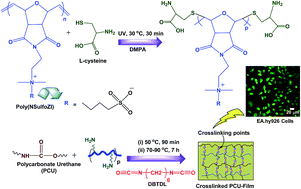Manipulation of polycarbonate urethane bulk properties via incorporated zwitterionic polynorbornene for tissue engineering applications
Abstract
Elastomeric crosslinked materials based on polycarbonate urethane (PCU) and zwitterionic polynorbornene were designed by thiol–ene click-chemistry and crosslinking reaction. The zwitterionic polynorbornene poly(NSulfoZI) with functionalisable double bonds was first treated with L-cysteine via thiol–ene click-reaction and subsequently formed a crosslinked structure upon treatment with PCU in the presence of a small amount of hexamethylene-1,6-diisocyanate as a crosslinking agent. The obtained materials possessed improved tensile strength (14–20 MPa) and initial modulus (8–14 MPa). All of these materials showed high breaking strain (εb 740–900%) except the material with a high poly(NSulfoZI) content of 28% (εb 470 ± 80%). The biodegradability of these materials was enhanced compared to blank PCU, as demonstrated by testing in PBS for five weeks. Moreover, the cytocompatibility was studied by MTT assay. The adhesion and proliferation of endothelial cells (EA.hy926) over a one-week period indicated that cell growth on these designed material surfaces was enhanced. Therefore, these zwitterionic polynorbornene-modified PCU-based materials could be suitable candidates for tissue engineering applications.


 Please wait while we load your content...
Please wait while we load your content...